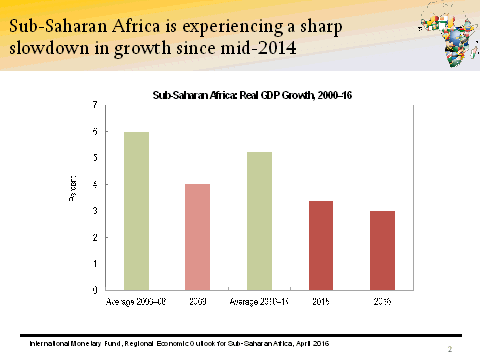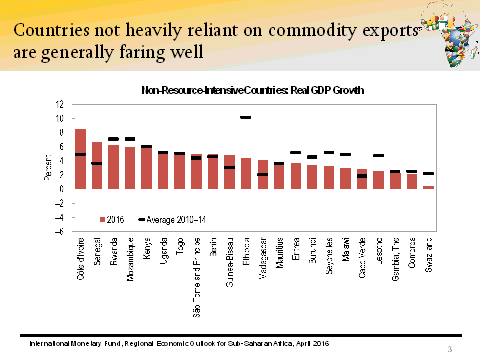The Challenges of Sustaining Africa’s Growth Momentum
May 9, 2016
First Deputy Managing Director, IMF
Strathmore University, Nairobi, Kenya, May 9, 2016
As Prepared for Delivery
I would like to thank the Strathmore University for agreeing to host my lecture on the regional economic outlook for sub-Saharan Africa. I would also like to thank Dr. George Njenga, the Dean of the Strathmore Business School, for hosting the event. I greatly appreciate the opportunity for sharing my views and analysis on prospects for the region with students, faculty, and professional economists.
Africa has just experienced a 15-year period of remarkable growth and development. These considerable economic achievements have helped to transform the world’s view of this region, and have given new hope for the future. However, in the past year we have seen the outlook darken for some countries as external developments affect many of the drivers of Africa’s recent economic success.
What I would like to do today is talk about these recent developments—starting with the significant gains since the mid-1990s and then outlining the reasons behind the recent slowdown. Finally, I will highlight how Africa can continue to grow with sound economic policies that can ensure favorable medium-term prospects.
My message is simple: Sub-Saharan Africa has come a long way in a short time, and there is every reason to believe that it can continue growing and developing with the appropriate policy response.
Africa Resurgent
Let’s begin with the period that became known as Africa Rising. After 1995, this region has experienced strong growth and an impressive improvement in social and human development indicators. More than two-thirds of the region’s 45 countries enjoyed ten or more years of uninterrupted growth. Millions of Africans have benefited. The achievements included more educated populations and sharp declines in infant mortality. In Kenya, for example, enrollment in primary schools increased by 25 percentage points and mortality for children under 5 years old declined by 6 ½ percentage points.
Africa’s trade also grew rapidly. This occurred largely in response to demand from emerging market countries that overtook the advanced economies as Africa’s main trading partners, particularly China.
Africa became an important destination for capital flows from both advanced and emerging market countries. Frontier market economies, such as Kenya, Senegal, and Zambia, issued Eurobonds and became more closely integrated into global financial markets.
This remarkable improvement in economic and social indicators occurred thanks to three driving forces:
(i) improvements in governance that produced a business and macroeconomic environment more conducive to investment,
(ii) higher commodity prices that benefited the exporters of natural resources, especially the region’s eight oil exporters, and
(iii) accommodative global financial conditions, which boosted capital flows and allowed countries like the ones I just mentioned to tap international markets at affordable terms.
Rough Patch
Since you are studying business and economics, I am sure you are well aware how the external environment has become much less supportive in the past year. At the global level, 2016 is going to be marked again by subdued growth, forecast to reach 3.2 percent, barely more than the 3.1 percent recorded last year. This forecast is underpinned by important macroeconomic realignments underway, including: (i) China’s slowdown and rebalancing; (ii) a further decline in commodity prices, especially oil; (iii) a related slowdown in investment and trade; and (iv) declining capital flows to emerging market and developing economies.
Sub-Saharan Africa is particularly feeling the effects of lower commodity prices and the less affordable financing terms. The result is that the strong growth of recent years has decelerated rapidly.
Growth weakened markedly in Sub-Saharan Africa in 2015, to 3½ percent—the lowest level in 15 years. The slowdown should continue into 2016, with growth projected at 3 percent—roughly half the rate Africa has grown accustomed to.

The current slowdown is particularly pronounced in some of the larger economies that are also commodities exporters (e.g., Angola, Nigeria, and South Africa), and, more recently the countries hit by drought in eastern and southern Africa (e.g., Ethiopia and Zambia). It’s worth noting that if we take Nigeria and South Africa out of the forecast, regional growth is essentially one percentage point higher.
So far, the picture I am painting is pretty negative. But that is not the whole story. In fact, many African countries continue to register robust growth: one-third of the countries in the region are enjoying growth above 5 percent this year. This is in line with the recent trend, as can be seen here in this slide for oil-importing countries.

This is particularly the case here in Kenya and more broadly in the East African Community. The countries making up the Community should register 6 percent growth this year. Similarly, growth will continue to be rapid in Côte d’Ivoire (8½ percent), Senegal (6½ percent), and many low-income countries in the region—as they continue to benefit from lower oil prices.
International Factors and Risks
Let me say a few additional words about some of the international factors affecting the outlook. The commodity price shock obviously has been severe. Crude oil prices in the 18-month period through end-2015 declined more than in any similar period since 1970. It’s been a similar situation for other commodities, especially iron ore, which has fallen even more than oil. We do not see an end to the commodities shock in this decade. Although now commodity prices are recovering from multi-year lows, there is still a non-negligible risk that they could decline again and further undermine growth prospects of commodity-producing countries.
This is all closely related to developments in China. Excluding commodities, this region has always had a trade deficit with China. But during the commodity boom Sub-Saharan Africa ran a trade surplus with China. This large trade surplus has turned into a deficit in less than a year. There is no reason to think that China is going to return to rapid levels of growth that drove global growth after the 2008 financial crisis. That train has left the station. But China will remain a force in the global economy. There is a risk that China’s rebalancing will proceed faster than projected in the IMF’s April 2016 World Economic Outlook. If that happens, Sub-Saharan Africa may grow even less.
Tighter financial conditions are also going to be a continuing fact of life. There is a degree of uncertainty about financial market developments that is bound to make money harder to come by for African borrowers.
Slower global economic growth has produced considerable tightening of financing conditions. There is a clear increase in risk aversion that is leading to a sharp retrenchment in global capital flows. Last year, for example, emerging markets saw about $200 billion in net capital outflows, compared with $125 billion in net capital inflows in 2014. This money is going to safe harbors. Should net capital flows to Sub-Saharan Africa be lower than expected because of adverse developments in global markets, frontier emerging market countries in the region could face more limited external financing opportunities. This, too, will have negative consequences for economic growth.
Domestic Factors and Risks
What are the domestic and regional factors? In our view, the key challenge is to implement in a timely manner the policy adjustments necessitated by the slowdown. Without these adjustments, there is a risk that some countries will face financing difficulties and an even more abrupt adjustment later.
The ongoing drought in eastern and southern Africa also is a risk. It could become prolonged or be felt over a larger area. Kenya fortunately is not affected. Similarly, an intensification of the security challenges in the region would have a pervasive macroeconomic impact affecting trade, investment, tourism, and revenue mobilization. I know that you are well aware of this issue, and I would like to state unequivocally that the IMF will stand with you.
It is perhaps easy to look at the current situation and jump to bleak conclusions about Sub-Saharan Africa’s prospects. But I believe that this is far too pessimistic.
We remain optimistic about the region’s medium-term growth prospects. More specifically, key drivers of growth, including an improved business environment and favorable demographics, remain in place.
Need for Action
But to realize the region’s potential, African policy makers need to act now. This was the message of our most recent Regional Economic Outlook for Sub-Saharan Africa, released last week and available on the IMF website.
The need for action is most urgent among natural resource exporters whose policy response so far has tended to be “behind the curve.” With rising fiscal deficits, falling international reserves, and severe financing constraints, adjustment is now unavoidable. The required policy steps include a reduction in fiscal deficits, and for countries outside monetary unions, exchange rate flexibility.
Countries that do not export commodities, including Kenya, are more favorably placed to weather the slowdown. In many of these countries, fiscal and current account deficits have been elevated over the last few years as they have taken advantage of the favorable financing conditions to address extensive infrastructure gaps. Now these countries should recalibrate their policies to adjust to limited domestic and foreign financing options. They should use their current strength to contain increases in public debt, pursue prudent monetary policy focused on low inflation, and build up international reserves. These policies will reduce their vulnerability to a more severe deterioration of the economic climate.
The current situation is also a reminder of the still substantial reform agenda that lies ahead. Now is the time to move forward with that agenda. Countries should find ways to further mobilize domestic revenues and create a sustainable tax base from non-commodity sectors. This is the most durable way to fund important social and infrastructure development. At the same time, countries should maintain momentum toward their longer-term development goals by better prioritizing development spending. The reform list is long: economic diversification, structural transformation, financial sector development, and good governance. All are more critical than ever if Africa is to create new sources of growth and ensure that the people of this region continue to see their lives improve.
The IMF has been a close partner in Africa’s journey, and we are supporting the region through this rough patch. The IMF tailors policy advice to specific challenges facing Sub-Saharan Africa’s countries. We support this advice with extensive technical assistance and training, including through five technical assistance centers in the region and the Africa Training Institute in Mauritius.
The IMF also provides significant financing support, including through zero-interest rate loans to its poorest members. And we innovate. For example, Kenya is the first country in Sub-Saharan Africa to benefit from the IMF’s insurance-like support. This means that the country has access to up to $1.5 billion dollars and can use these resources if adverse external developments create a need for additional foreign exchange.
Conclusion
So where does that leave us? Clearly, Africa is facing a challenging new reality. The external environment is not as favorable as it was up to 2014, but there are still many reasons for optimism. Africa—and Kenya—has every reason to look to the future with a positive outlook. There are many steps on the reform front that need to be taken to address these changed circumstances, but previous successes show that the region can rise to the challenge.
It is the students in the room who will be asked to tackle these challenges in the coming years. I believe you will make important contributions to a region that can continue its upward trajectory through the 21st century.
IMF COMMUNICATIONS DEPARTMENT |
| Media Relations |
|---|
| E-mail: media@imf.org |
| Phone: 202-623-7100 |


